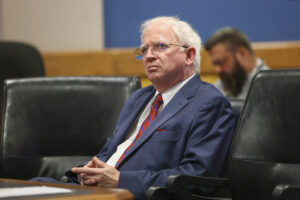California’s Forests Are Permanently Stunted
Trees have grown less fire-resistant, affecting the state's plans to fight climate change. The Mosquito Fire in the Volcanoville community of El Dorado County, California. Photo: Noah Berger / AP.
The Mosquito Fire in the Volcanoville community of El Dorado County, California. Photo: Noah Berger / AP.
Ecosystems aren’t landscape paintings so much as mosaics, with different pieces that grow and change over time. In healthy forests, patches of recent disturbance, such as fire or logging, sit alongside patches of grasses and shrubs, fast-growing trees and centuries-old mature forests. But these ecological patterns require a climate stability that no longer exists.
Due to human-caused climate change, California’s forest mosaics are vanishing. According to a study published in AGU Advances last July, the state’s forests lost almost 7%, or just over 1,700 square miles, of tree cover since 1985. That’s an area larger than Yosemite National Park. In particular, forests in California’s southwestern mountains lost 14% of tree cover.
Jon Wang, the study’s lead author and an Earth systems scientist at the University of Utah, said that at the current rate, “in a hundred years, we will have lost almost 20% of our forests. That’s like all of Southern California’s forests being gone, or all of the Southern Sierras being gone.”
Thousand-year-old forests now get only a decade or less between fires to recover. California’s forests are “never going to get a chance to become old-growth forest again,” Wang said. Instead, they may have “more of a permanent stunted state.” And aridification means that forests once considered fairly fire-resistant, such as old-growth coastal redwoods, can no longer rely on wet weather conditions for fire protection.
The dramatic loss of many of California’s giant sequoias, ancient trees that lived with fire for thousands of years, particularly troubles Wang’s co-author James T. Randerson, an Earth systems scientist at the University of California, Irvine.
“You can extrapolate out what’s going to happen to the forest,” Randerson said. “It’s horrific.”
In the southern mountains, where forests are dying even without fires because of drought stress, chaparral may replace trees permanently.
To track how California’s forests changed over the past few decades, researchers used machine learning, training an algorithm to identify vegetation types in satellite images taken every few days, dating back to 1985. The algorithm differentiated between three causes of tree death: wildfires, logging and drought. As it turns out, far more of California’s tree cover is disappearing due to wildfires than from drought or logging.
The sheer amount of data that this study provides is important, said Philip Higuera, a fire ecologist at the University of Montana, who was not involved with the research. “The ability to quantify changes, not only from fire, but from forest die-back, and from timber extraction—to be able to do all of those three at once—is really valuable, because it helps place them in context” throughout California, Higuera said.
To be clear, wildfires remain a natural part of healthy forest ecosystems across the West, and controlled burns are important tools in forest management. But California has a fire deficit. Colonizers stamped out Indigenous fire-management practices, so fuels keep building up, leading to ever more destructive conflagrations. Today, the astronomical costs of living in California’s cities encourage people to move into forests, and fires follow. And those fires, combined with drought, are quickly changing California’s ecosystems.
With effective fire management, some Northern California forests might eventually grow back. But in the southern mountains, where forests are dying even without fires because of drought stress, chaparral may replace trees permanently.
One limitation of this study is its timescale. “Thirty-five years is a long study from the perspective of using satellite data, but in the context of forest development and ecosystem change, it can still be relatively short,” Higuera said. Wang and Randerson also cautioned that this research doesn’t model future fire recovery, so more work needs to be done before drawing conclusions about whether these ecosystem changes are permanent.
Meanwhile, California is proposing an ambitious plan to achieve net-zero greenhouse gas emissions by 2045. Right now, Wang said, the carbon offset market is really focused on growing trees. But his data suggests that California may have to lower its expectations. “We might be moving to a paradigm of saving what’s there,” he said.
Your support matters…Independent journalism is under threat and overshadowed by heavily funded mainstream media.
You can help level the playing field. Become a member.
Your tax-deductible contribution keeps us digging beneath the headlines to give you thought-provoking, investigative reporting and analysis that unearths what's really happening- without compromise.
Give today to support our courageous, independent journalists.






You need to be a supporter to comment.
There are currently no responses to this article.
Be the first to respond.